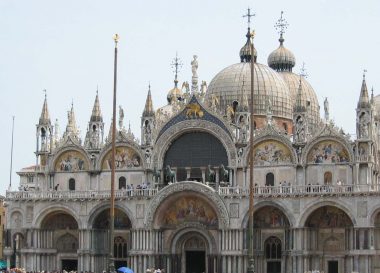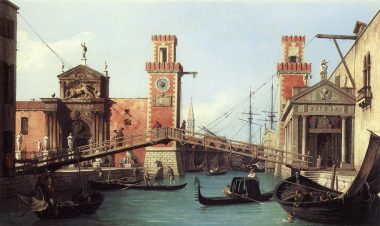During the Middle Ages, the Venetians held both religious and commercial power; a combination which allowed them to influence western Europe considerably. The Venetians were able to use their religious significance, symbolized in the grandeur of St. Mark’s, to instigate military action in the name of religion, such as the Fourth Crusade. Furthermore, Venice’s maritime power, symbolized in the historic remembrance of their galleys, provided the ships and supplies needed for such endeavors. However, most Venetian travel to the East was not militaristic. The Venetians were renowned for their merchant activities. They used the trade rights they had gained through military strength to import goods from the Byzantine Empire and encourage their spread throughout the West. This is evidenced by the sale of sugar, a naturally eastern crop, in west European markets beginning in medieval times.
Examining the connections between Venetian galleys, European sugar sales, and St. Mark’s Cathedral is but a small example of a larger principle; that all aspects of world history are intertwined, and it is the job of the historian to unravel such connections.
The Venetians, with their trademark galleys, became the most prominent figures in trade between western Europe and the Byzantine state. This would prove extremely beneficial for the Venetians in the years to come. Following the First Crusade in 1096, western Europeans increased their demand for goods from the East. Those who had fought in the Crusade had experienced many luxuries previously scarce or unseen in the West. It was the Venetians, with their favorable trading privileges, that were able to transport such goods to regions where they were most in demand. However, the newfound Venetian wealth and arrogance provoked the people of Constantinople. In 1171, goods were confiscated from all Venetian merchants within the Byzantine sphere, and, soon after, Constantinople established trade agreements with Venice’s rivals, the Italian city-states of Genoa and Pisa.



The hostilities between Constantinople and Venice erupted when Venice used its commercial power to influence the rest of western Europe into conducting a raid of Constantinople in the Fourth Crusade which began in 1202. The Venetians had offered their vast navy to transport Crusaders to Egypt. This naval attachment included many of the famed galleys, including a 50 galley escort. However, the Venetians skillfully influenced the Crusaders and diverted the troops to Constantinople where they seized the city in 1204. First, the Venetians supported placing Alexius, the son of the emperor deposed in a Byzantine civil war, on the throne. However, they soon overthrew him in favor of a Latin emperor. During this seize of Constantinople, the Venetians, or, rather, the Crusaders under their influence sacked the city and looted many of its treasures. These treasures were subsequently brought to the West. It was not merely Venice’s commercial power that allowed it such influence in the Fourth Crusade. The Venetians also made an effort to exert religious authority in the West.
This power is seen in the image of St. Mark’s Cathedral, which stands in Venice as a symbol of the religious significance that the city once held. The church was purportedly built in honor of St. Mark when his bones and relics were brought to Venice from Alexandria. It is said that two Venetian merchants stole these artifacts from a shrine in Alexandria and smuggled them to Venice in a barrel of pork which would not be searched by the Muslims. The Church was then rebuilt in the 11th century to stand as it does today.



St. Mark’s clearly shows the influence the Byzantine Empire had on the West. Trade between the West, namely the Venetians, and the Byzantines had spread not only goods, but also ideas such as architectural concepts. St. Mark’s was built using the domes and mosaics found throughout Byzantine constructs. In fact, the mosaics of St. Mark’s are estimated to cover an area one acre. Furthermore, the Church is home to many artifacts from Constantinople itself. These relics were brought to St. Mark’s after the looting which took place during the Venetian-led Fourth Crusade in 1204. Some of the most famed pieces from Constantinople include four bronze horses and the Pala d’Oro.
The Byzantine architecture that can still be seen in St. Mark’s is not the only lasting effect of Venetian maritime endeavors. Their commercial trade had far reaching results as well, including bringing aspects of the Islamic Green Revolution to western Europe. This can be clearly seen in the sugar sales which took place in west European markets. During the Green Revolution Muslims began to institute new irrigation methods and cultivate new crops brought from India, Southeast Asia, and Africa. Sugar was one such new crop. It was originally cultivated in India and brought to the lands of the Sassanid Empire around the 7th century. When Muslims took over former Sassanid lands, they also adopted sugar cane cultivation. Though some sugar was brought to western Europe when the Muslims invaded Spain and Sicily, it was through trade that the crop spread significantly. West European traders, such as the Venetians, gained the crop from the East; namely from the Byzantine Empire though there was some Venetian trade with regions further east. The Byzantines, in turn, had received sugar cane through trade and other interactions with the Arabs. Thus, one can see how Venetians, through their vast trading network, led to the western European sale of sugar; a food which is still a staple in west European nations today.
